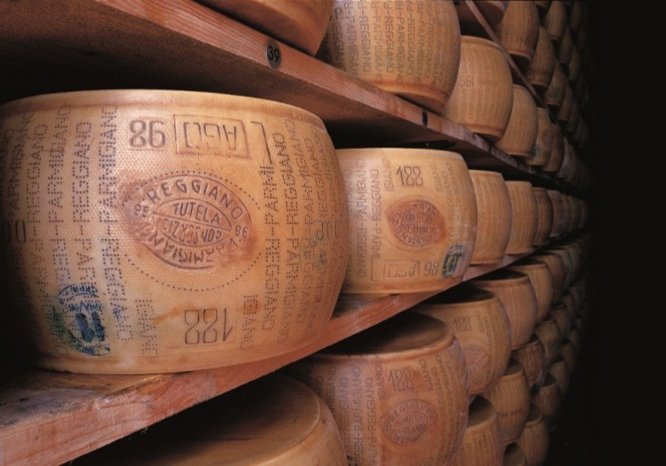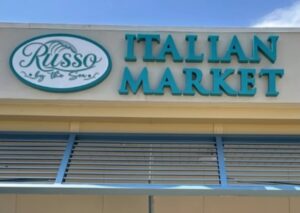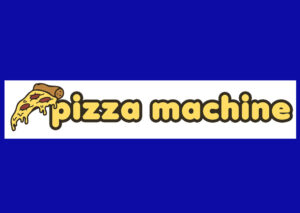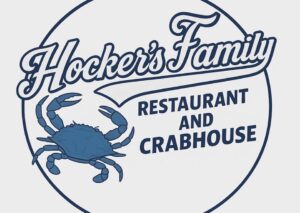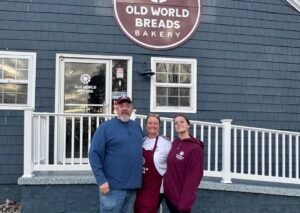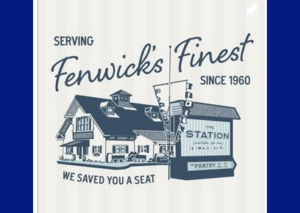C. Fadiman said, “Cheese is milk's leap for immortality.” This adage is often quoted, but what he didn’t say was that only one cheese actually made it to immortality. Yes, other cheeses with their respective cows, sheep and goats have made the leap over the moon, but only one qualifies for immortality; judged by a man who taps each cheese with a mallet and listens for the heavenly choir. Well, actually, he is listening for imperfections – or perfection. But the result is the same: Parmigiano-Reggiano. (In the USA, Reggiano Parmesan.)
There is only one Parmigiano-Reggiano, and its majesty is protected by European Law with a “DOP” (Protected Designation of Origin) added to each cheese to denote its compliance with those laws. The manufacture of Parmigiano-Reggiano is restricted to an area in north central Italy, primarily Reggio Emilia and Parma. It is from those areas that the name was derived. There is a saying by producers that Reggiano Parmesan is made, not manufactured. So be it – they should know.
Reggiano Parmesan is made every day from skimmed raw cow’s milk and calf's rennet, a friendly bacteria (in a “starter” form; a bit like a sourdough starter). The only other ingredient is carefully controlled heat followed by a little more carefully controlled heat after the curd has been formed and broken. The fledgling cheese is shaped, pressed, rested for a couple of days and then imprinted, after which it basks in a three-week saltwater bath that creates the unique rind. The salinity of the bath is the same as the salinity of the Mediterranean Sea, which, as this cheese is produced a hundred miles from the coast, strikes me as a bit romantic but wonderfully Italian.
I would like to point out that the resulting whey (the liquid remaining after the cheese is made) is fed to the local pigs. Their butts (aka the legendary Prosciutto di Parma) are almost as famous as the cheese. Well, it is the farmer's whey, after all.
The biggest problem that arises at this point is what you do to the cheese as you age it for a year or two (or more). The medieval solution had a bit of renaissance about it: They created cooperatives – “cheese banks” or warehouses – where the cheeses were aged. The warehouses morphed into cheese storage and eventually became distributors with quality as their primary criteria. Remember our cheese tapper from paragraph 1? That’s how he found his job.
In 1934 this process was formalized, and it is now the Consortium that dictates and monitors the standards for the production and distribution of this great product. At 12 months, there is a Consortium stamp branded on to each wheel after our tapper has had his way with it. The cheeses are aged for another six months, adjudicated yet again, and sold or put aside for extra aging which could last another six months or, in rare cases, even several years.
The older the cheese, the denser and nuttier it becomes. For me, the two year olds have a perfect balance; a creamy texture right before a grassy mouth-explosion. The red wines of the region, namely Sangiovese and Chianti, are a perfect tasting complement. Its enveloping aroma and exclusive taste makes Parmigiano Reggiano an irreplaceable element in the kitchen. It can enhance the flavor and aroma of soups, it enriches many meat courses, embellishes salads, and is a delightful accompaniment to aperitifs, raw vegetables such as celery and cherry tomatoes, and fresh fruit and nuts. Parmigiano Reggiano is a complete and essential food and a delicious answer to a balanced diet in today’s lifestyles. In contrast to its delicate taste, it can be accompanied by a not-too-spicy chutney (kiwi, apricot, melon). In addition to the Italian reds I mentioned above, the combination of the cheese with fruits and vegetables can be served with a dry white wine.
And I'll let you in on a secret: A sliver of matured Parmigiano Reggiano takes on a wonderful new dimension with the addition of a few drops of traditional balsamic vinegar from Modena or Reggio Emilia.
The Reggiano Parmesan served at Touch of Italy (the largest user in Sussex County; 6-10 80-pound wheels per month!) is a two year old with the additional consortium quality imprint: “Export.” Enjoy the cheese grated, sliced or in bulk at any of the Touch of Italy restaurant/delis. If I’m there, introduce yourself and tell me you liked this article.
Attend one of Bill's popular cheese classes at Touch of Italy. Click here for more info.


